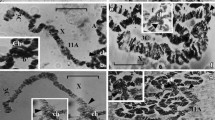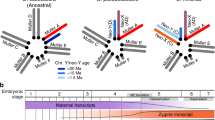Abstract
In situ hybridization experiments demonstrate the wide distribution of (CA/GT)n repeats within the genome of Drosophila hydei. (CA/GT)n sequences are evenly distributed in the euchromatin of autosomes and the X chromosome but are not present in most of the heterochromatin of the sex chromosomes. Both sex chromosomes carry one large block of (CA/GT)n. At least part of this (CA/GT)n cluster in the Y chromosome is transcribed in a strandspecific manner and at a high rate in primary spermatocyte nuclei. Also, in polytene chromosomes, specific transcription of (CA/GT)n sequences is found in certain puffs as demonstrated by transcript in situ hybridization. The X chromosomal euchromatin carries approximately twice as much (CA/GT)n over its entire length as the autosomes. These observations are discussed with respect to the mechanisms of dosage compensation and position-effect variegation. A possible biological role of (CA/GT)n sequences, which has been the subject of controversy among various investigators, is their involvement in the control of the rate of transcription.
Similar content being viewed by others
References
Aiken JM, Miller DA, Hagen F, McKenzie DI, Krawetz SA, Sande JH van de, Rattner JB, Dixon GH (1985) Tandem repeats of a specific alternating purine-pyrimidine DNA sequence adjacent to protamine genes in the rainbow trout that can exist in the Z form. Biochemistry 24:6268–6276
Belote JM (1983) Male-specific lethal mutations of Drosophila melanogaster. II. Parameters of gene action during male development. Genetics 105:881–896
Belote JM, Lucchesi JC (1980) Control of X chromosome transcription by the maleless gene in Drosophila. Nature 285:573–575
Cline TW (1978) Two closely linked mutations in Drosophila melanogaster that are lethal to opposite sexes and interact with daughterless. Genetics 90:683–698
Dorn R, Heymann S, Lindigkeit R, Reuter G (1986) Suppressor mutations of position-effect variegation in Drosophila melanogaster affecting chromatin properties. Chromosoma 93:398–403
Hamada H, Petrino MG, Kakunaga T (1982) A novel repeated element with Z-DNA-forming potential is widely found in evolutionarily diverse eukaryotic genomes. Proc Natl Acad Sci USA 79:6465–6469
Hareven D, Zuckerman M, Lifschytz E (1986) Origin and evolution of the transcribed repeated sequences of the Y chromosome lampbrush loops of Drosophila hydei. Proc Natl Acad Sci USA 83:125–129
Hartmann-Goldstein IJ (1967) On the relationship between heterochromatization and variegation in Drosophila with special reference to temperature-sensitive periods. Genet Res 10:143–159
Hazelrigg T, Levis R, Rubin GM (1984) Transformation of white locus DNA in Drosophila: dosage compensation, zeste interaction and position effects. Cell 36:469–481
Hennig W (1985) Y chromosome function and spermatogenesis in Drosophila hydei. Adv Genet 23:179–234
Hennig W (1986) Heterochromatin and germ line-restricted DNA. In: Hennig W (ed) Germ line — soma differentiation. Results and problems in cell differentiation. vol 13. Springer, Berlin Heidelberg New York Tokyo, pp 175–192
Hennig W, Huijser P, Vogt P, Jäckle H, Edström J-E (1983) Molecular cloning of microdissected lampbrush loop DNA sequences of Drosophila hydei. EMBO J 2:1741–1746
Hipskind RA, Clarkson SG (1983) 5′-flanking sequences that inhibit in vitro transcription of a Xenopus laevis tRNA gene. Cell 34:881–890
Huijser P, Hennig W (1987) Ribosomal DNA-related sequences in a Y chromosomal lampbrush loop of Drosophila hydei. Mol Gen Genet 260:441–451
Kremer H, Hennig W, Dijkhof R (1986) Chromatin organization in the male germ line of Drosophila hydei. Chromosoma 94:147–161
Krumm A, Roth GE, Korge G (1985) Transformation of salivary gland secretion protein gene Sgs-4 in Drosophila: stage- and tissue-specific regulation. Dosage compensation, and position effect. Proc Natl Acad Sci USA 82:5055–5059
Lucchesi JC, Skripsky T (1981) The link between dosage compensation and sex differentiation in Drosophila melanogaster. Chromosoma 82:217–227
Miesfield R, Krystal M, Arnheim N (1981) A member of a new repeated sequence family which conserved throughout eucaryotic evolution is found between the human δ and β globin genes. Nucleic Acids Res 9:5931–5947
Mukherjee AS, Beermann W (1965) Synthesis of ribonucleic acid by the X-chromosome of Drosophila melanogaster and the problems of dosage compensation. Nature 207:785–786
Mukherjee AS, Chatterjee SN (1975) Chromosomal basis of dosage compensation in Drosophila. VIII. Faster replication and hyperactivity of both arms of the X-chromosome in males of Drosophila pseudoobscura and their possible significance. Chromosoma 53:91–105
Muller HJ (1932) Some genetic aspects of sex. Am Nat 66:118–138
Muller HJ (1950) Evidence of the precision of genetic adaptation. Harvey Lect 43:165–229
Nordheim A, Rich A (1983) Negatively supercoiled simian virus 40 DNA contains Z-DNA segments within transcriptional enhancer sequences. Nature 303:674–679
Pardue ML, Nordheim A, Möller A, Weiner LM, Stollar BD, Rich A (1984) In: Bennett MD, Gropp A, Wolf U (eds) Chromosomes Today. Vol VIII. Allen & Unwin, Inc., Worchester, MA, pp 34–35
Pfeiffer RA (ed) (1973) Modern aspects of cytogenetics: Constitutive heterochromatin in man. Symposia Medica Hoechst 6. FK Schattauer-Verlag, Stuttgart, New York, pp 87–99
Pukkila PJ (1975) Identification of the lampbrush chromosome loops which transcribe 5S ribosomal RNA in Notophthalmus (Triturus) viridescens. Chromosoma 53:71–89
Rich A, Nordheim A, Wang AHJ (1984) The chemistry and biology of left-handed Z-DNA. Annu Rev Biochem 53:791–846
Scholnik SB, Morgan BA, Hirsh J (1983) The cloned Dopa-decarboxylase gene is developmentally regulated when reintegrated into the Drosophila genome. Cell 34:37–45
Smith GP (1976) Evolution of repeated DNA sequences by unequal crossover. Science 191:528–535
Spofford JB (1976) Position-effect variegation in Drosophila. In: Ashburner M, Novitski E (eds) The genetics and biology of Drosophila, vol 1c. Academic Press, London, pp 955–1018
Spradling AC, Rubin GM (1983) The effect of chromosomal position on the expression of the Drosophila xanthine dehydrogenase gene. Cell 34:47–57
Steinmann-Zwicky M, Nöthiger R (1985) A small region on the X chromosome of Drosophila regulates a key gene that controls sex determination and dosage compensation. Cell 42:877–887
Streisinger G, Okada Y, Emrich J, Newton J, Tsugita A, Terzaghi E, Inouye M (1966) Frameshift mutations and the genetic code Cold Spring Harbor Symp Quant Biol 31:77–84
Tautz D, Renz M (1984) Simple sequences are ubiquitous repetitive components of eukaryotic genomes. Nucleic Acids Res 12:4127–4138
Vogt P, Hennig W (1986a) Molecular structure of the lampbrush loop nooses of the Y chromosome of Drosophila hydei. I. The Y chromosome-specific repetitive DNA sequence family ay1 is dispersed in the loop DNA Chromosoma 94:449–458
Vogt P, Hennig W (1986b) Molecular structure of the lampbrush loop nooses of the Y chromosome of Drosophila hydei. II. DNA sequences with homology to other genomic locations are a major constituent of the loop Cromosoma 94:458–467
Vogt P, Hennig W, ten Hacken D, Verbost P (1986) Evolution of Y chromosomal lampbrush loop DNA sequences of Drosophila. Chromosoma 94:367–376
Author information
Authors and Affiliations
Rights and permissions
About this article
Cite this article
Huijser, P., Hennig, W. & Dijkhof, R. Poly(dC—dA/dG—dT) repeats in the Drosophila genome: a key function for dosage compensation and position effects?. Chromosoma 95, 209–215 (1987). https://doi.org/10.1007/BF00330352
Received:
Issue Date:
DOI: https://doi.org/10.1007/BF00330352




